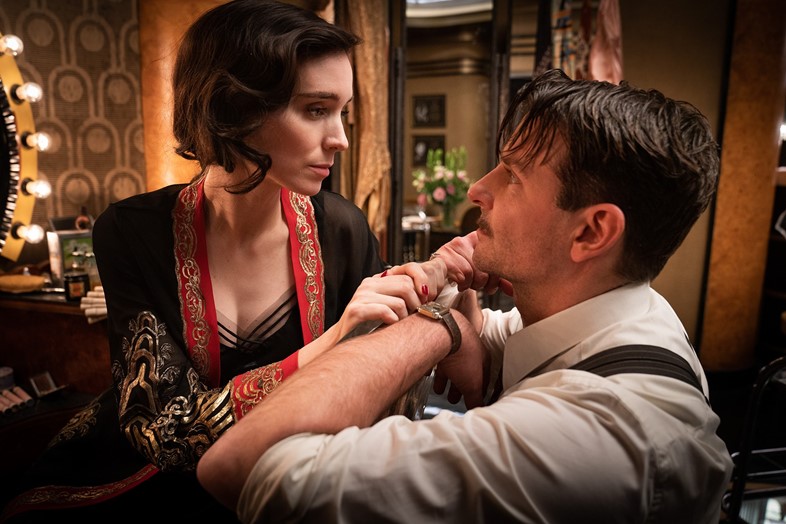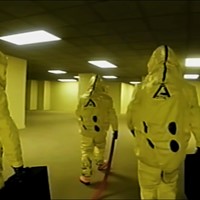‘It’s about unlocking the human monster’: The actor discusses her role in Guillermo del Toro’s new film noir, which takes us into the bizarre world of carnivals
Guillermo del Toro is known for his grotesque creations. In Pan’s Labyrinth, the Mexican director dreamed up a child-eating demon with eyes in its palms; in Cronos, a vampire licks blood off a public bathroom’s floor. For his 11th feature, Nightmare Alley, his first without fantastical elements, del Toro deploys the noir genre to showcase a new type of monster: Cate Blanchett as a psychoanalyst with a murderous edge.
Mixing fraud with Freud, Lilith Ritter (Blanchett) upends the 1940s-set thriller on its painterly head. For the first hour, Stan (Bradley Cooper) toils at a carnival before fleeing with a romantic partner, Molly (Rooney Mara). He then moonlights as a mentalist, faking an ability to read wealthy minds – except Lilith can out-scheme a schemer. In 1999, Blanchett depicted a naïve socialite who’s duped in The Talented Mr Ripley; two decades later, Lilith may as well be renamed The Talented Ms Ritter.
“Guillermo, more than any other director, is fascinated by monsters,” Blanchett, 52, tells me over the phone from London in mid-January. “But in this one, it’s about unlocking the human monster. There’s a dark, monstrous creature inside Bradley that he’s in absolute denial of. My character encourages him to face that monster. It’s a dance of death. She knows that one of them’s going to be destroyed by it.”
Del Toro is the second director to adapt William Lindsay Gresham’s 1946 novel for the screen. In the book, Gresham wrote that Lilith bears “the smile of a well-fed kitten” and laughs with “the bark of a fox”; in del Toro’s screenplay, which he penned with Kim Morgan, Lilith is “an icy woman of indeterminate age”. Helen Walker’s interpretation in the 1947 movie is more of a fake friend – a nightmare ally, if you will.
“Hopefully Lilith is an enigma,” Blanchett says. “Someone who’s completely unknowable. Anyone who’s been in psychoanalysis is desperately trying to unlock the recesses of their therapist’s mind. It’s a magnetic pull, because they seem to be like the Sphinx – they hold the answer to all the riddles they ask you. But in the end, they hold a mirror up to yourself.”
In a jagged, microphone-rigged office decorated like an image from a captcha test, Lilith welcomes Stan into her lair. As she treats numerous upper-class patients, Lilith provides Stan with their deepest, most sordid secrets, enabling him to continue his con; often these exchanges unfold in whispers, both leaning in for a kiss but settling for a flirtatious, breathy conversation that, coincidentally, propels the story along. At circuses, a geek – a performer who bites live chickens – is typically an alcoholic in need of booze; here, the psychoanalyst drip-feeds Stan with sex and romance, knowing he’ll do anything if the affection suddenly evaporates.
Then again, Lilith feeds off Stan, too, because everyone in Nightmare Alley self-medicates. It could be opium, it could be love. “Or maybe it’s acting!” Blanchett interjects. “The set was incredibly claustrophobic. I didn’t leave that office for four weeks. It’s like I was in the Amber Room, buried three storeys underground. Apart from the Copacabana, you never see her outside, whereas Stanley’s out in the world. He’s an instrument. A blunt instrument, unfortunately. She’s hoping he’s a Stradivarius, but it turns out he’s just an Okie with straight teeth.”
Blanchett is both a modern A-lister – her recent credits include a Leo DiCaprio-seducing TV host in Don’t Look Up, and the CGI-contorting Hela in Thor: Ragnarok – and a performer suited to period pieces. Comfortable as a young Bob Dylan in I’m Not There and Katharine Hepburn in The Aviator, Blanchett inhabits Lilith as a classical femme fatale of the black-and-white era. “But normally the motivations of a femme fatale are in service of the plot, whereas I felt with Lilith there’s a higher purpose to it. Stan believes his lies, and my character is trying to unlock the truth in all its terrifying hideousness.”
Because I welcomed Blanchett “into my office” at the start of the phone call, the interview is littered with references as to how I’m the Lilith Ritter of our chat – until I describe Lilith’s voice as seductive and motherly. “Ooh, seductive and motherly,” she says. “Does that say more about you or me? Who’s on the couch now! Well, I think the room’s a psychic space as much as a physical office. It was important to have a voice that felt like it was inside Stan’s head, because he’s in such denial about who he is, what’s motivating him, and his ineptitude.” She also sought to create a hybrid between how people speak now and in the forties. “Hopefully the voice is timeless.”
In 2019, Stanley Kubrick’s assistant, Leon Vitali, revealed that Blanchett did uncredited voice work on Eyes Wide Shut. When Tom Cruise attends the orgy, the masked woman played by Abigail Good was overdubbed by Blanchett. “That happened after the fact,” she recalls. “I wasn’t allowed to see the film. It’s always a strange thing, when you’re asked to voice somebody else.”

So were Cruise and Nicole Kidman, who both recommended Blanchett, searching for someone vocally seductive (the character is nude) and motherly (she also rescues Cruise)? “They didn’t use the word ‘motherly’.” So just seductive? “Yeah. I mean, if you look at the sequence, it’s very strange and dreamlike and otherworldly – and a psychic space. Maybe that’s what they were after.”
In Britain, BAFTA longlisted Blanchett for Don’t Look Up; in America, SAG nominated her for Nightmare Alley. When I ask if there’s a cultural divide, she opts to skip the question and instead emphasise that Nightmare Alley is intended for the big screen. “It’s cinematic,” she continues. “There’s nothing like sitting with strangers in the dark, watching things. A master like Guillermo, having big, big, epic thoughts, in all of this glorious visual wonderment? It’s delicious.” Do people in the UK have a moral duty to see it in theatres? “A moral duty? Uh… OK, I’ll let you say that. That’s a good one.”
However, Blanchett describes Nightmare Alley, and its deconstruction of the American Dream, as a topical film, even if it’s set in the forties. “But it couldn’t be further from agitprop. It’s set in a circus and a world that feels familiar but strange. It provides us with a space, in an entertaining way, to reflect on what’s going on, without having it banged over our heads.”
So if it gets remade in 50 years’ time when the planet is underwater, will it still resonate? “Guillermo might be right for that remake – he’s good with underwater creatures. Look, you can’t view anything at the moment without reflecting on what we’re going through as a species. But this had been brewing for Guillermo and Kim for quite a long time. He’s really obsessed with how monstrous we’ve become when we start to believe our own lies. And that feels like an incredibly resonant theme to explore.”
Nightmare Alley is out in UK cinemas now




